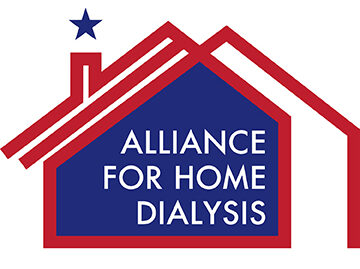Home Dialysis
Today, more than 807,000 Americans are living with end-stage renal disease (ESRD), an almost fifteen-fold increase compared to 1980. This number will likely continue to increase, as an estimated 31 million people in the United States have chronic kidney disease and are at risk for kidney failure. Due to the limited number of kidneys available for transplantation, the vast majority of ESRD patients, approximately 70 percent, depend on dialysis to replace kidney function.
There are two types of home dialysis: peritoneal dialysis (PD) and home hemodialysis (HHD).
PD treatment uses a special solution injected into the individual’s abdominal cavity to filter blood and remove wastes. This process occurs several times during a 24 hour period and can be done at home or in the workplace. Individuals treated with PD can also use a machine, known as a cycler, at night to perform exchanges while sleeping.
Hemodialysis (HD) is a treatment in which an artificial membrane, known as a hemodialyzer, filters the blood. This is the most common type treatment used in the dialysis facility.
Typically, individuals receiving in-center HD follow a strict treatment schedule, visiting a dialysis clinic three times a week for approximately 3 to 5 hours at a time. HHD is performed at home using the type of dialysis machine used in a facility or a portable hemodialysis machine both of which require assistance by a partner, such as a spouse or caregiver. HHD treatments may be performed in a variety of regimens and schedules to meet the clinical and lifestyle needs of patients. Most often, HHD therapy is done 5-6 times a week.
Utilization
Today, about 13.7% of the 807,000 U.S. dialysis patients receive treatment at home. In its implementation of the End Stage Renal Disease Prospective Payment System (ESRD PPS), CMS maintained equal payments across home and in-center dialysis, with the stated goals of promoting “patient independence and use of home dialysis whenever appropriate.” This policy helped contribute to modest growth in home dialysis in recent years.
However, data suggests that barriers still remain for optimizing the availability and utilization of home dialysis. In its October 2015 report, “Medicare Payment Refinements Could Promote Increased Use of Home Dialysis,” the Government Accountability Office estimated that up to 25% of dialysis patients could realistically dialyze at home.
There are significant regional and racial disparities in the utilization of home dialysis. Utilization rates for PD vary from 12.9% in Maine to 29.1% in Alaska; for HHD, from 1.1% in California to 6.6% in West Virginia. Additionally, the variance in utilization is even greater by race; African American dialysis patients are approximately 29 percent less likely than average to receive PD and 5 percent less likely to receive HHD, while Hispanic dialysis patients are about 14 percent less likely than average to receive PD and 43 percent less likely than average to receive HHD.
Multiple U.S. studies demonstrate that when educated about the option, 40-50% of patients choose home dialysis. The current utilization rate suggests that there are an array of systematic barriers may be hampering efforts to optimize utilization of home dialysis for those patients who are appropriate candidates.
Quality of Life Benefits
The benefits of home dialysis have been well documented in peer reviewed medical literature, including improvements in physical, mental health, and nutritional status. For instance, because HHD offers more frequent and/or lasting dialysis sessions, studies demonstrate individuals have a quicker recovery time after treatment and have an increased opportunity for rehabilitation. PD patients experience fewer negative side effects, such as nausea and weight gain, and dietary restrictions than in-center patients.
Home dialysis also provides significant economic and lifestyle advantages:
- Greater autonomy and flexibility over when a patient dialyzes;
- Reduced dependence on transportation, as there is no travel to a clinic for treatments;
- More conducive for work, which is demonstrated by higher rates of employment among home dialysis patients.
